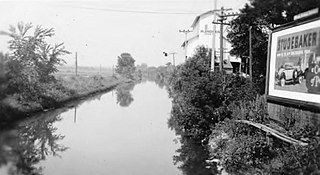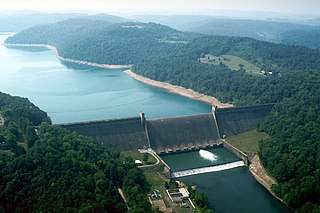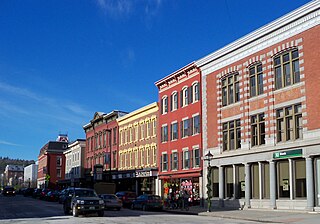
The Illinois and Michigan Canal connected the Great Lakes to the Mississippi River and the Gulf of Mexico. In Illinois, it ran 96 miles (154 km) from the Chicago River in Bridgeport, Chicago to the Illinois River at LaSalle-Peru. The canal crossed the Chicago Portage, and helped establish Chicago as the transportation hub of the United States, before the railroad era. It was opened in 1848. Its function was partially replaced by the wider and deeper Chicago Sanitary and Ship Canal in 1900, and it ceased transportation operations with the completion of the Illinois Waterway in 1933.

Fulton Ferry is a small area adjacent to Dumbo in the New York City borough of Brooklyn. The neighborhood is named for the Fulton Ferry, a prominent ferry line that crossed the East River between Manhattan and Brooklyn, and is also the name of the ferry slip on the Brooklyn side. The neighborhood is part of Brooklyn Community District 2.

Lincoln Harbor is a station on the Hudson–Bergen Light Rail (HBLR) located at Waterfront Terrace, north of 19th Street, in Weehawken, New Jersey. The station opened on September 7, 2004. There are two tracks and an island platform.

The following is a list of Registered Historic Places in Keweenaw County, Michigan.
This National Park Service list is complete through NPS recent listings posted April 22, 2022.

Rockland Harbor Breakwater Light is a historic lighthouse complex at the end of the Rockland Breakwater in the harbor of Rockland, Maine. Replacing a light station at Jameson Point, the light was established in 1902, about two years after completion of the breakwater. Now automated, it continues to serve as an active aid to navigation. The light was added to the National Register of Historic Places as Rockland Breakwater Lighthouse on March 20, 1981.

The Port of Dubuque is the section of downtown Dubuque, Iowa that lies immediately adjacent to the Mississippi River. The area was among the first areas settled in what would become the City of Dubuque, and the State of Iowa. Historically, the area has been a center of heavy industry, but has recently seen extensive reinvestment and new construction. The area is now one of the main tourist destinations in Dubuque, as well as Iowa.
There are more than 350 places listed on the United States National Register of Historic Places in Chicago, Illinois, including 83 historic districts that may include numerous historic buildings, structures, objects and sites. This total is documented in the tables referenced below. Tables of these listings may be found in the following articles:

The Atchison, Topeka and Santa Fe Passenger and Freight Complex is a nationally recognized historic district located in Fort Madison, Iowa, United States. It was listed on the National Register of Historic Places in 1992. At the time of its nomination it contained three resources, all of which are contributing buildings. The buildings were constructed over a 24-year time period, and reflect the styles that were popular when they were built. The facility currently houses a local history museum, and after renovations a portion of it was converted back to a passenger train depot for Amtrak, which opened on December 15, 2021.

Munson Valley Historic District is the headquarters and main support area for Crater Lake National Park in southern Oregon. The National Park Service chose Munson Valley for the park headquarters because of its central location within the park. Because of the unique rustic architecture of the Munson Valley buildings and the surrounding park landscape, the area was listed as a historic district on the National Register of Historic Places (NRHP) in 1988. The district has eighteen contributing buildings, including the Crater Lake Superintendent's Residence which is a U.S. National Historic Landmark and separately listed on the NRHP. The district's NRHP listing was decreased in area in 1997.

Heron Neck Light is a lighthouse on Green's Island in Vinalhaven, Maine at the south end of Penobscot Bay. It was established in 1854 as an aid to navigation for Vinalhaven's main port, and for the Hurricane Channel extending northwest from Heron's Neck. The light was automated in 1984. It was listed on the National Register of Historic Places as Heron Neck Light Station on January 21, 1988.

The Montgomery Ward Company Complex is the former national headquarters of Montgomery Ward, the United States' oldest mail order firm. The property is located along the North Branch of the Chicago River at 618 W. Chicago Avenue in Near North Side, Chicago, Illinois. It was listed on the National Register of Historic Places and as a National Historic Landmark on June 2, 1978.

The Brandon Road Lock and Dam is a lock and dam complex along the Des Plaines River in Joliet, Illinois. The complex was built from 1927 to 1933 in conjunction with the construction of the Illinois Waterway, which allowed for barge travel between Lake Michigan and the Mississippi River. The lock and dam are also used to regulate water levels on the river between Lockport and Joliet. The lock at the complex is 110 by 600 feet and has four Miter gates, with a 34-foot drop. The dam is 2,372 feet (723 m) long and includes concrete and earthen segments. The complex also includes a disused junction lock for the Illinois and Michigan Canal, the control station for the lock, and a modern pump house.

Starved Rock Lock and Dam, also known as Lock and Dam No. 6, is a lock and dam facility managed by the U.S. Army Corps of Engineers along the Illinois River. It is part of the Illinois Waterway and was constructed between 1926 and 1933. The lock and dam was added to the National Register of Historic Places as the Starved Rock Lock and Dam Historic District in 2004.

Tygart Dam — also known as Tygart River Dam — is a federally built and operated dam in Taylor County, West Virginia, United States. The dam regulates the waters of the Tygart Valley River. Its storage reservoir is known as Tygart Lake. Most of the lakeshore is occupied by Tygart Lake State Park and Pleasant Creek Wildlife Management Area. The structure was listed on the National Register of Historic Places in 1995.
Walter Mickle Smith, Sr. was a civil engineer who worked primarily on U.S. dams and waterway projects. He was a consulting engineer on the construction of the Panama Canal and Panama Canal Locks and later served as design engineer for the New York Board of Water Supply. He spent much of his career with the State of Illinois waterways division and was its chief engineer until his retirement in 1937. Several of his works built in the 1920s and 1930s as part of the Illinois Waterway project are listed on the National Register of Historic Places, including portions of the Brandon Road Lock and Dam, the Dresden Island Lock and Dam, the Lockport Lock and Power House, and the Marseilles Lock and Dam.

The Nashua Manufacturing Company Historic District in Nashua, New Hampshire, is a historic district that was listed on the National Register of Historic Places (NRHP) in 1987. It encompasses an area just west of downtown Nashua, roughly located along the southern bank of the Nashua River, bordered on the west side by Mine Falls Park, on the south side by the Nashua River canal, up to Ledge Street, and from the east side by Factory, Pine and Water streets, up to the Main Street bridge.

The Peoria Lock and Dam is a historic lock and dam complex on the Illinois River at Creve Coeur, Illinois. The complex was built in 1938-39 as part of an effort to make the river navigable and establish a route for barges between Chicago and the Mississippi River. The U.S. Army Corps of Engineers designed the complex; their influence is particularly evident in the dam's control station, as the State of Illinois designed most other dam control stations along the river. The lock has a standard 100-by-600-foot chamber, similar to other locks on the river, and a vertical lift of 11 feet (3.4 m). The dam is 536 feet (163 m) long and includes 108 wicket gates and a Tainter gate; it is one of two Illinois dams that still use wicket gates. The control station is for the most part a large, functional building, though it has Art Deco surrounds at the main entrance. The district also contains an original maneuver boat designed to raise and lower the dam's wicket gates; the boat is still used and is one of four boats of its kind left in the United States.

The Joseph "Diamond Jo" Reynolds Office Building and House is a historic building located in McGregor, Iowa, United States. Joseph "Diamond Joe" Reynolds was a New York native who started working in a gristmill in the 1840s. As the grain belt moved to the west, he moved with it, settling in Chicago in the 1850s and McGregor around 1860. Because of difficulties accessing steamboats to ship grain down the Mississippi River, he established the Diamond Jo line in 1866. It grew to become a major player in the transportation industry. He had its headquarters moved from Fulton, Illinois to Dubuque, Iowa in 1874. By the late 1870s railroads had taken over as the primary means of shipping grain, and Reynolds turned his attention to passenger boats. He had this combination office and residential building constructed in 1885. Reynolds died in 1891 and his widow sold the building before her death in 1895. It has subsequently housed grain trader offices, a billiard parlor, the post office, a winery, shops, and apartments.

The Montpelier Historic District encompasses much of the historic commercial and government district of Montpelier, the state capital of Vermont. The city center, focused on the confluence of the Winooski River with its North Branch, has been economically driven by state government since 1805, and had industry powered by the rivers. Its center reflects a diversity of 19th century architecture. In addition to the Vermont State House, the district includes The Pavilion, the commercial downtown area, and residential areas to the east and north. It was listed on the National Register of Historic Places in 1978, and enlarged in 1989 and 2018.

The Dubuque Freight House is a historic building located in Dubuque, Iowa, United States. Built by the Chicago, Burlington and Northern Railroad (CB&N) in 1901, this was the third and last freight house built by a railroad in the Ice Harbor area. The other two facilities were built by the Illinois Central Railroad (1872) and the Chicago, Milwaukee and St. Paul Railroad (1874). These other two railroads were older, larger, and monopolized the bridge and tunnel that crossed the Mississippi River. The CB&N was fortunate that their freight house was located along the water's edge in that the river boats could tie up next to the building and load and unload cargo, and the railroad put box cars on ferries that docked in the Ice Harbor. The Dubuque Boat and Boiler Works were headquartered on the west end of the facility for 20 years beginning in 1952. Founded in 1852 as the Iowa Iron Works, they provided engines, boilers and other equipment for river boats, and water craft for the United States Navy, United States Coast Guard, and the United States Army Corps of Engineers. The building was listed on the National Register of Historic Places in 1979. It is now a part of the National Mississippi River Museum & Aquarium.




















